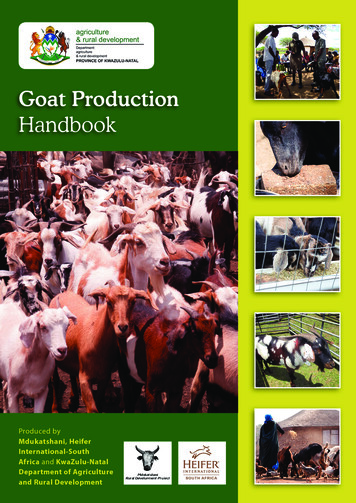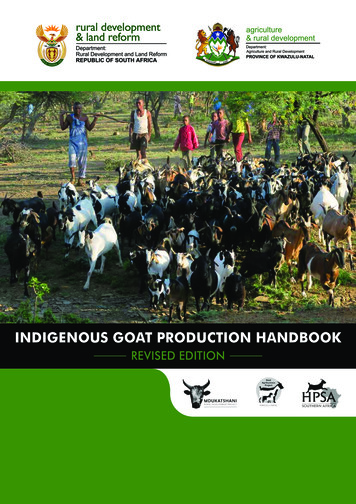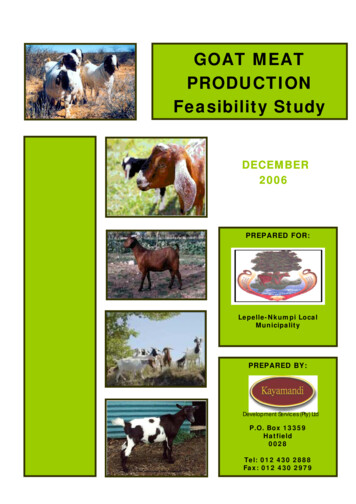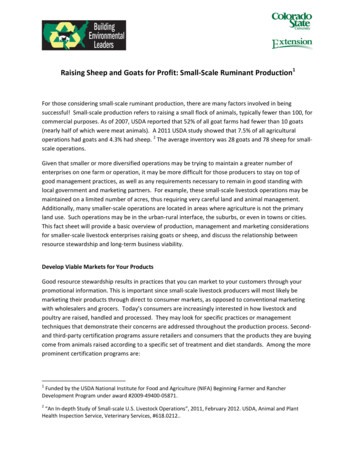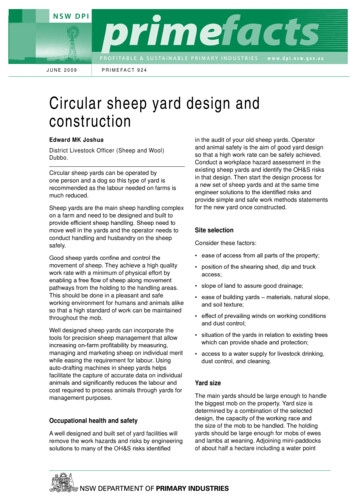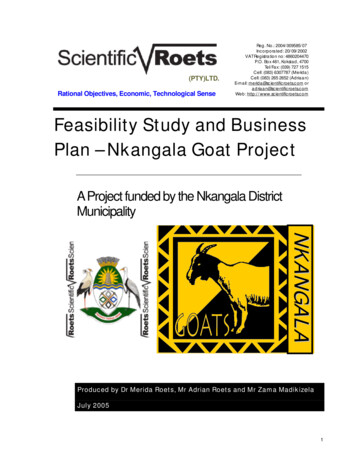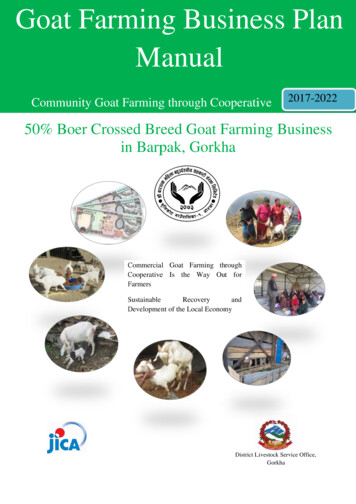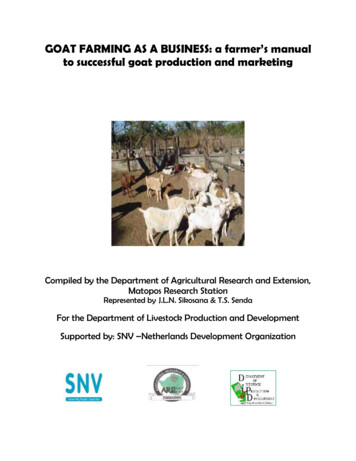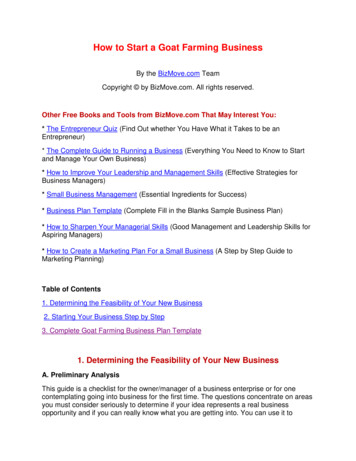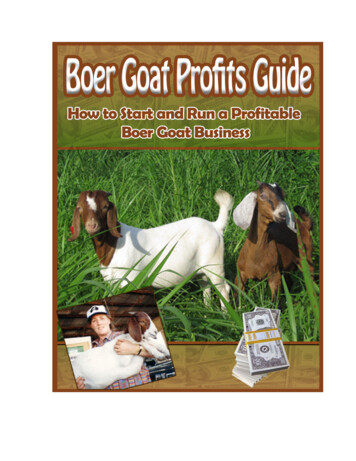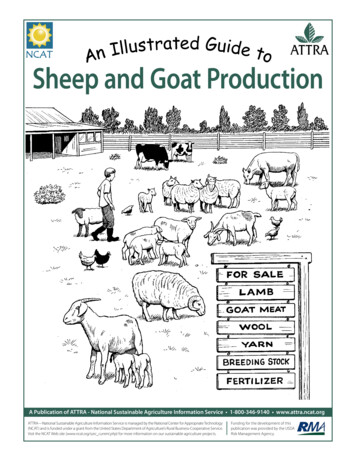
Transcription
trated Guide tsullIoAnATTRASheep and Goat ProductionContentsA Publication of ATTRA - National Sustainable Agriculture Information Service 1-800-346-9140 www.attra.ncat.orgATTRA—National Sustainable Agriculture Information Service is managed by the National Center for Appropriate Technology(NCAT) and is funded under a grant from the United States Department of Agriculture’s Rural Business-Cooperative Service.Visit the NCAT Web site (www.ncat.org/sarc current.php) for more information on our sustainable agriculture projects.Funding for the development of thispublication was provided by the USDARisk Management Agency.
ContentsRelated ATTRA PublicationsSelection. 3Feeding and Pasture . 5Breeding andYoung Stock . 8Health . 12Equipmentand Handling . 15Marketing . 16Conclusion . 18 Goats: SustainableProduction Overview Small RuminantSustainability Checksheet Meat Goats: Sustainable Production Managing Internal Parasites inSheep and Goats Dairy Goats: Sustainable Production Sustainable Sheep Production Pasture, Rangeland and GrazingManagement Dairy Sheep Ruminant Nutrition for GraziersResources . 18INTRODUCTIONSheep and goats are versatile animals and can be valuable and enjoyable additions tomany farms.MILKFIBERBRUSH CONTROLMEATPASTURE AND RANGE IMPROVEMENTFollowing are some things you need to know before adding sheep or goats to your farm.Page 2 An Illustrated Guide to Sheep and Goat Production800-346-9140
SELECTIONYour sheep or goat business will be much more enjoyable and successful if you begin withhealthy animals with proper conformation. These are characteristics you should look forwhen selecting stock.GOOD GOAT CONFORMATIONLevel RumpWide, Deep and Long LoinLevel TopWellMuscledLegFeet and Legs SetSquarely Under AnimalLong, Trim NeckDeep BodyAdequateBone (notfrail)GOOD SHEEP CONFORMATIONSmooth ShouldersWide-SetFront LegsStrong, StraightPasternHead UpLong, LevelRumpAnimals withgood conformation are: Strong instructureWell-MuscledLegWide Chest Wide chestedDeep Body Able to walksquarely onfeet and legsGood BoneSize & StructureAnimals in goodhealth are:AVOID ANIMALS WITH SIGNS OF POOR HEALTH Robust Alert Deep bodiedHead DownMessy Behind Bright eyed LivelyHealthy goatsare shiny witha smooth coatand are free ofabscesses.www.attra.ncat.orgTail DownSwollen jointsLimpingUntrimmed FeetAn Illustrated Guide to Sheep and Goat Production Page 3
SELECTION continuedDoes and ewes should have a well-balanced udder with two functional teats.GOODAvoid animals with really small orreally large teats. Other uddersto avoid:ONE-SIDEDTOO BULBOUSSelect animals with good teeth and a proper bite. You can determine an animal‛s age by looking at its teeth.MILK TEETH (BabyTeeth): Less than 1 yearof age2 ADULT TEETH:1 YearALL 8 ADULT TEETH:4 years4 ADULT TEETH:2 yearsWORN MOUTH orBROKEN MOUTH:Over 5 years of agePage 4 An Illustrated Guide to Sheep and Goat Production6 ADULT TEETH:3 yearsGUMMY: Aged800-346-9140
FEEDING AND PASTURE Goats prefer to browse, or eat things such as brush, leaves, and small trees. Sheep prefer to eat broadleaf plants (forbs) and grasses. Sheep and goats are able to select the most nutritious parts of a plant.SHEEP GRAZINGGOAT BROWSINGDIVERSE, HEALTHY PASTURE Sheep and goats like to havea variety of forages to choosefrom. If you provide diverse foragesto your animals, they are ableto select a diet that meetstheir nutritional needs.A mixture of grasses andbroadleaf plants It is important to always provide a clean water supply andfresh minerals.Maintain proper forage height; don‛t let your animals graze forage under two inches.OVERGRAZEDwww.attra.ncat.orgSPOT GRAZEDTOO SHORTJUST RIGHTTOO TALLAn Illustrated Guide to Sheep and Goat Production Page 5
FEEDING AND PASTURE continued Proper fencing is necessary for sheep and goat production. You must have adequate fencing in place before getting animals! There are many options to keep animals in and predators out.WOVEN WIRE WITHBARBED WIREMULTIPLE STRANDSOF BARBED WIREPORTABLE ELECTRICNET FENCINGOFF-SET ELECTRIC FENCEFIVE STRANDS OFELECTRIC WIREMULTIPLE STRANDS OFELECTRIC POLYTAPEThere are many methods for dealing with potential predators.GUARDIAN DOGDONKEYLLAMANIGHT PENNINGPage 6 An Illustrated Guide to Sheep and Goat ProductionGOOD FENCE800-346-9140
FEEDING AND PASTURE continued Allow pastures and forages a time to rest after periods of grazing. Having multiple pastures or paddocks (see below) to rotate animals through will useforages more efficiently. Use a combination of permanent and portable fencing to subdivide paddocks. Numbers indicate possible number of paddocks and grazing sequence.Single PaddockPortable FenceSTRIP ROTATIONAL GRAZING Sheep, goats, and cattle have different forage preferences. The animals won‛t competefor food, and pastures will be evenly grazed. You can run different species together, or you can follow one species with another in arotation.MULTI-SPECIES GRAZINGIt is importantto manage forages so thatanimals maintain properbody condition.You don‛t wantyour animals toofat or too thin.Look at spine,hip bones, ribs,and legs.www.attra.ncat.orgTOO THINTHINSATISFACTORYSATISFACTORYBUT TENDINGTOWARDS FATTOO FATAn Illustrated Guide to Sheep and Goat Production Page 7
FEEDING AND PASTURE continued Occasionally hay or grain will have to be fed.Use proper feeders to keep feed clean andoff of the ground. Use a hay feeder to reduce waste. There are various options for feeders.BREEDING AND YOUNG STOCKThe foundation of your herdis the herd sire. It is worthspending money and attention ona good buck or ram.MEAT GOAT BUCKUse caution when handlingbucks and rams, and nevertreat them as pets.Selection considerations: Fertility Health and hardiness Adaptation to environmentand management Internal parasite resistance Body type Marketing goalsPage 8 An Illustrated Guide to Sheep and Goat Production800-346-9140
BREEDING AND YOUNG STOCK continuedIf ewes and does are at least 3/4 of their adult size, they can lamb or kid at one year of age.FULL GROWN ADULT1/2 OF ADULT SIZE DO NOT BREED3/4 OF ADULT SIZE MAY BE BREDThe usual breeding season isAugust to January. Kids andlambs will arrive five months afterbreeding.SIGNS OF HEATCALCULATING DUE DATESdate BREDdate DUEJan. 1May 31Feb. 10July 10Mar. 2July 30Apr. 1Aug. 29May 1Sept. 28June 30Nov. 27July 30Dec. 27Aug. 29Jan. 26Sept. 28Feb. 25Oct. 28Mar. 27Nov. 27Apr. 26Dec. 27May 26Turn the buck or ram with the females five monthsbefore you want the kids or lambs to be born.Watch the herd or flock and note breeding activity.Records are useful for decision-making. Here is an example of a kidding dedNo. inLitterSireCommentsAn Illustrated Guide to Sheep and Goat Production Page 9
BREEDING AND YOUNG STOCK continuedThis is how a kid or lamb is normally born. It usually takes about an hour of labor.Colostrum (the first milk) contains vital antibodies and nutrients. Be sure all kids and lambsreceive colostrum shortly after birth. Contact your vet or ATTRA for more information onnewborn care.Disbudding dairy goat kids (to be donebefore 10 days of age):1. heat iron2. restrain kid3. hold hot iron over horn bud as shown for10-20 seconds.4. check for copper rings on both horn buds.Copper-colored ringsWear heavyleatherglovesElastrator tool for docking tailsand castrating lambs and kids.Elastrator bands(about the size of aCheerio)Page 10 An Illustrated Guide to Sheep and Goat Production800-346-9140
BREEDING AND YOUNG STOCK continuedTESTICLESCastrating with elastrator (to be done before 10 days of age).Rudimentary teats (besure they are not pinched)Be sureboth testiclesare below theelastrator bandDocking a lamb‛s tail with elastrator.Midway—still tooshortTooshortWhere todockProper place to dock tailHair sheep do not need tohave their tails docked.All animals should be permanently identified with ear tags, tattoos, or ear notching.Avoid the vein.PROPER TAG PLACEMENT All states require certain sheep and goats tobe officially identified on change of ownership,as part of USDA‛s Scrapie program.TAG STYLES Call 1-866-USDA-TAG for information and torequest your free tags.www.attra.ncat.orgAn Illustrated Guide to Sheep and Goat Production Page 11
HEALTH Healthy, productive animals are more profitable and enjoyable to raise.Refer to the Selection section for signs of healthy and sick animals. It is important to have a working relationship with a veterinarian.A veterinarian can help with prevention, diagnosis, and treatmentof disease.Keep recordsof healthtreatments,includingday of treatment eatmentComments Internal parasites are one of the primary health concerns for sheep and goat producers. Parasite eggs are passed by the animals, and infective larvae are picked up from pasture.Signs of parasitisminclude:INTERNAL PARASITE LIFE CYCLEAdultEggsEnters worms pass intostomachmateintestine Rough hair coatEggspassout infeces Thin/unthrifty Bottle jaw AnemiaBOTTLE JAWEatenbyanimalROUGH HAIR COAT, THINEggshatchInfective stagePage 12 An Illustrated Guide to Sheep and Goat Production800-346-9140
HEALTH continuedFAMACHA Compare color of eyelidto FAMACHA card FAMACHA is a tool usedto identify anemic animals(a sign of parasitism). Byusing FAMACHA producers can identify and treatonly the animals that needdeworming. This system is usefulwhere barberpole wormsare the main parasite.Contact your veterinarianto learn more aboutFAMACHA . Also seewww.scsrpc.org.There are many vaccinationsthat can be given. The mostcommon vaccinations are CD-T(clostridium/overeating diseaseand tetanus).Injection methodsSUBCUTANEOUSWhen administering drugs, payclose attention to dosages andwithdrawal periods. Most drugshave a withdrawal time formeat and milk.INJECTION SITESINTRAMUSCULARXAlligator clip for securityStringRectal ThermometerInserted in rectum,just under tail.www.attra.ncat.org Knowing how to take youranimals‛ temperature ishelpful in determining signs of illness. Normal temperature of sheep andgoats is 102 FAn Illustrated Guide to Sheep and Goat Production Page 13
HEALTH continuedOccasionally sheep and goats need to have theirhooves trimmed. Keeping hooves trimmed helps animals to walk properly and helps prevent other hoofproblems such as foot rot.TRIMMING SHEEP HOOVESDig dirt out from toes.Trim, parallel to hoof hairline, all loose excess nail.Pare heels to same levelas toes.Snip away growthbetween toes.Pare the soft heel tissueuntil hoof surface is smoothand flat.Finished hooves. Good health depends on you! To prevent disease, provide: Good nutrition, with plenty of forage Good sanitation Low-stress environment and handling Protection from predators Good pasture management Vaccinations as recommended byyour veterinarian. Observe your animals and respond quickly to any problems. Animals who are poor producers or have chronic health problems should be culled.Page 14 An Illustrated Guide to Sheep and Goat Production800-346-9140
EQUIPMENT AND HANDLING Sheep and goats are easy to handleand do not require a lot of equipment.THREE-SIDED SHELTERS WITH OPEN SIDEAWAY FROM PREVAILING WINDS ARE IDEAL. You should provide a shelter toprotect animals from rain, snow, andcold winds. There are many different shelteroptions, from simple structures tomore complex barns.PERMANENT BARNMOVEABLE SHELTER ON SKIDSHOOPED CATTLE PANELS WITH TIGHT TARP Clean, dry, well-ventilated shelters helpanimals stay healthy. Moveable shelters help preventmanure buildup in an area. Shelters and working facilities can behome built for lower cost.CATCH PEN AND CHUTEHEAD GATEA catch pen,chute, andhead gateare helpfulwhen workingwith sheepand goats.For verysmall flocks,a catch penis sufficient.www.attra.ncat.orgAn Illustrated Guide to Sheep and Goat Production Page 15
EQUIPMENT AND HANDLING continuedA scale is very useful. Knowing animal weight helpsyou: Monitor animal growthSCALE Calculate dosages of medications Decide when to market animals Determine a selling price Sheep can be restrainedby setting them on theirrump. Goats should be restrainedby holding them under thejaw and the rump. Sheep and goats are easierto control if you keep theirheads held high.MARKETING When marketing sheep and goats, it isimportant to determine who your customersare and what they want. Many religious and ethnic groups preferlamb and goat.Explore local options for selling your products. Market options include:ON-FARM SALESPage 16 An Illustrated Guide to Sheep and Goat ProductionSALE BARN800-346-9140
MARKETING continuedCOOPERATIVE SALEProducers pool their animals to sell alarge group to a buyer.WHOLESALESelling carcasses to butchershops and restaurants.GRADED SALEUSDA grader inspects animals. Heavier muscledanimals bring a premium.Sheep and goats can improve land bycontrolling brush or invasive weeds.Some landowners are willing to pay forthis service.www.attra.ncat.orgSelling packaged cuts.Other products:ORGANICGRAZING SERVICESRETAILFLEECEWool and mohair can be sold toindividuals or to a pooled sale.Higher grade fleeces will bring abetter price.You may exploreorganic sheep andgoat production.First determineif there is amarket and iforganic production would beprofitable. Contact ATTRA formore information.MILKRules for selling milkand milk products varyby state.An Illustrated Guide to Sheep and Goat Production Page 17
CONCLUSIONWherever you live, sheep and goats may have a place on your farm. You must first determine the goals foryour farm and then explore profitability of the sheep and goat enterprise. To learn more, see the resourceslisted on the next page.Page 18 An Illustrated Guide to Sh
Sheep and Goat Production A n I l l u s t r a ted G u i d e t o Funding for the development of this publication was provided by the USDA Risk Management Agency. Page 2 An Illustrated Guide to Sheep and Goat Production 800-346-9140 INTRODUCTION Sheep and goats are versatile animals and can be valuable and enjoyable additions to many farms. MILK BRUSH CONTROL MEAT PASTURE AND

